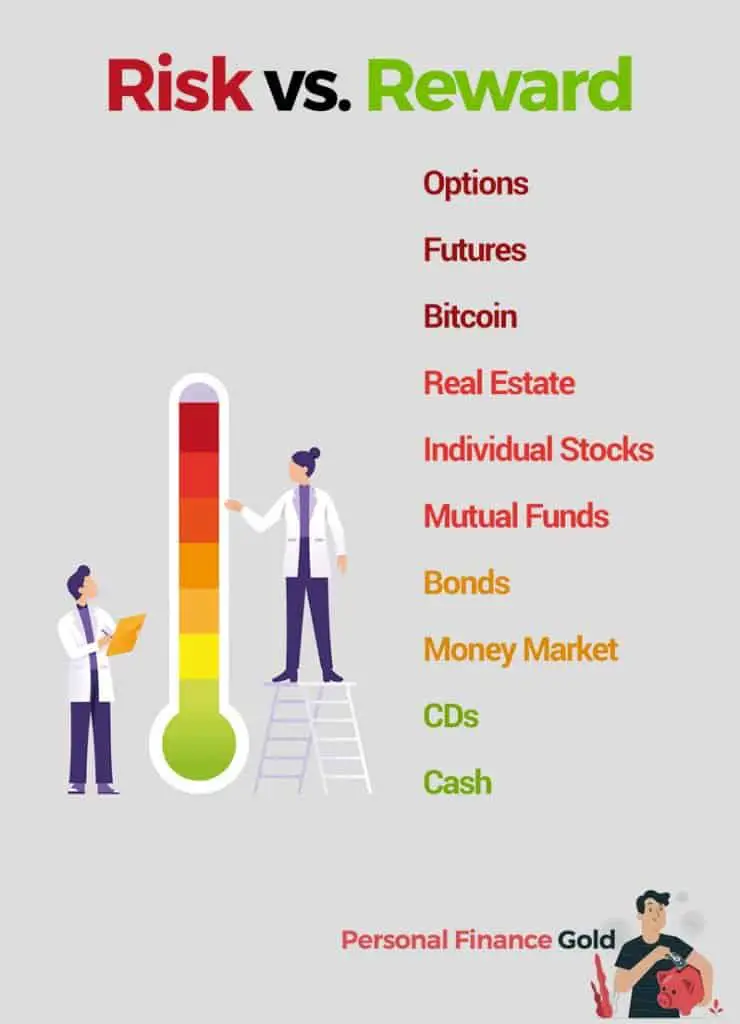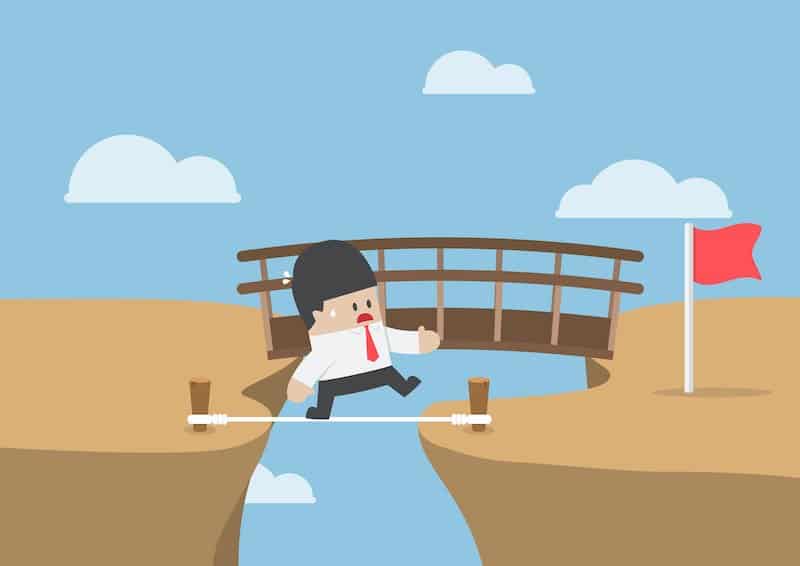During my school years, I always thought the smarter kids would have a better lifestyle. Graduating from college, I realized that nothing could be farther from the truth.
Those who were risk-takers in life (whether it’s their career choices or investments) were the ones that came out on top. When it comes to investing, what is the typical relationship between risk and return?
In regards to risk and return, the greater the risk you take, the greater your potential return. This is the case whether you’re investing in the stock market or buying an investment property.
What is Risk?
In finance, your risk is measured by the type of investment you’re about to make. Some investments are riskier than others, let’s take a look.
CDs, aka certificates of deposits, are some of the lowest risk investments. You’re basically letting the bank borrow some of your money, for a set period of time (like 6-months or 1-year), and you get a fixed rate of return based on that.
When you invest in the stock market, each individual company you choose to invest in can vary dramatically in terms of risk.
We know that penny stocks are some of the riskiest stocks available to purchase, with huge upside and downside swings. You could lose almost all your money in a matter of days, and also have potential tremendous returns too.
If you buy a stock like Walmart, the risk is fairly low, and you’d be riding it out for quite some time if you wanted solid returns.
What is Return?
The return is the other half of the coin. When you put your money towards an extremely low risk investment like CDs, your return might be extremely low, something like 0.50% return on investment.
If, instead, you invested in Bitcoin, your return could sway up and down dramatically as much as 10% in a month.
There is no exact correlation between risk and return, but we know that the more riskier investments definitely pay out some of the best rewards.
Take house flipping for example, especially if you’re buying foreclosure homes. Let’s make up a scenario.
You’re looking into buying a foreclosed home that the bank anxiously wants to get rid of, you find one that’s pretty distressed for $150k. You know you have to put another $50k into it to make it presentable, and hope to profit $50k on top of that.
Your total investment is: $200k
Your anticipated return is: $50k
Your risk is quite high, you hope that a potential buyer sees your renovated home, can imagine themselves in it, and put an offer to buy the home. At the same time, while you wait for the closing, you’re paying interest on the money you borrowed to buy this house (unless you paid all cash).
Your return could be huge, to the tune of 25% return, in a matter of 2-3 months that it takes to renovate and sell the property.
If you got the hang of it, you could potentially flip several homes a year and make tremendous returns in a year.
The return would be high, as well as your risk. If you played the house flipping game, you’d hope to reduce your risk over time by gaining experience from past mistakes, and not making them again.
How do I know my risk tolerance?
So understanding risk and return is pretty simple. The main aspect of all this, is knowing yourself. Are you able to take high risks in order to get high returns?
I personally can’t stand losing any more, I stress out a lot.
I started learning about investing in 2008, specifically buying stocks. I never got right into it, but I gained more and more interest over time.
In 2013, I started learning about binary trading on platforms like Nadex. You could basically buy a trade, predicting if a stock (or market index like S&P500) would be below or above a given number at a specific timeframe.
For example, I could buy a trade saying that the S&P would be above 20,000 by 4pm today. I’d buy it based on my research, hoping to earn that quick money.
I’d be right sometimes and celebrate big, and be wrong other times (alot) and get frustrated.
I did this off and on for about 2 years, before realizing that I hated it. It drove me nuts when I would be wrong, to lose my hard earned money. My formula had to work, what the hell was going on?
Whatever it was, I got out. Around the same time, I learned about risk tolerance and realized that I was pretty low on the scale for risk tolerance.

On a scale from 1-10, you measure your risk tolerance based on how comfortable you are with potentially losing your money, being wrong, and your overall goals.
Some people might have enough money to lose, they just hate losing. Others are okay losing once in a while, but don’t have the money to take big risks.
Knowing this, I gauged at the time that I was a 4 out of 10, a fairly low risk taker. I started loving value investing, a long term approach to making big money, and didn’t want to lose my hard earned money on risky bets.
Over the years, I would do a re-check on that number, and found that it’s still the same. Getting married, having a baby, buying a house, and all the other life events have still kept me at about a 4 on the risk tolerance level.
What’s your risk tolerance number?

In the beginning, you’re gonna have to make that number up. After a few months to a year, you can look back on the investment choices you made, and see if you’d rather have taken more or less risk to get the returns you were hoping for.
Do a re-check every year, and see how life’s changes make you adjust your risk/return levels. As you get older you naturally want to take less risk because of starting a family and having bigger purchases (house, cars, etc.).
Knowing your risk tolerance number is very helpful, because there are so many investment opportunities available, and it helps you filter out the ones that are not right for you so you can focus on mastering the ones that are.
How can I get the best of both worlds?
To get the best of both risk and return, you want to master the few investment opportunities that fit within your circle of risk tolerance.
If you’re a 2 on the risk tolerance level, you can master buying bonds, creating a bond ladder, investing in some of the lowest risk mutual funds, and so on.
If you’re an 8 on the risk tolerance level, you can master researching and buying individual stocks for high returns, investing in Bitcoin, and maybe doing binary trading like I mentioned earlier.
There are so many investment options, that it doesn’t make sense to try them all. Find the investment opportunities that fit within your circle of tolerance, and learn everything you can about them so you get solid returns for less and less risk over time.
Conclusion
Personal Finance Gold was meant to help you understand all the different investing, saving, and money management options you have out there.
Reflect on your past investments to see if you were totally stressed or comfortable with the outcomes. Find out your risk tolerance number, and

